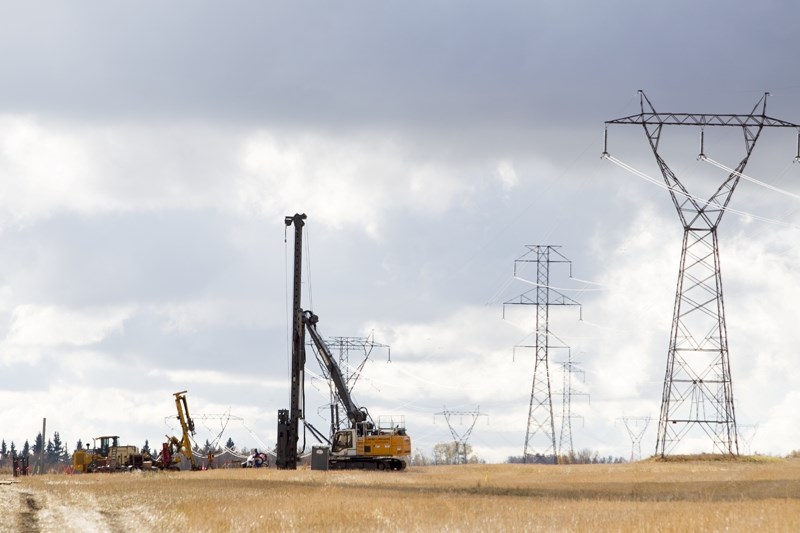Rimbey-Rocky Mountain House-Sundre MLA Joe Anglin said he believes that a $200-million increase in the estimated price tag for the Western Alberta Transmission Line (WATL) will be one of many cost jumps for the project.
“This line is outrageously expensive,” Anglin said. “This is not the end. This thing is still going to go up in price.”
AltaLink, the province's largest electricity transmission company, announced on Oct. 11 that the estimated cost of the WATL project has increased to $1.65 billion from $1.45 billion.
The 500-kilovolt line will, when completed, span 350 kilometres and transmit electricity between Edmonton and Calgary with part of the line running through Red Deer and Mountain View counties west of Innisfail and Olds and east of Sundre.
The reason for the price increase, the company states in a media release, is mainly because of “higher than forecast costs in the market for construction labour for the transmission line.”
Other reasons for the jump in costs were a longer-than-expected consultation program and project-permitting process and a directive from the Alberta Utilities Commission (AUC) to use 12 monopole structures rather than lattice structures where the line runs near the Gleniffer Reservoir, the company stated.
But Anglin, who has paid close attention to the WATL project since 2005, said although the project's original design catered to a need in the central part of the province, “politics interfered” and the line that is now being built will transmit more electricity than is needed in the Edmonton-to-Calgary region.
“What we're building now is a multi-billion dollar clothesline that we may or may not ever use and that is actually scary,” he said.
“We could have built an aircraft carrier for that price.”
He added there is already 2,200 megawatts of electricity capacity between Edmonton and Calgary right now but only 800 megawatts is actually transmitted on an average daily basis.
“So you can see we're underutilizing the existing lines as they sit today,” he said.
The WATL project, which is currently under construction, along with another transmission line project in development, he said, will increase capacity by a further 2,000 megawatts.
The increase in price for the WATL will also mean electricity consumers in Central Alberta will see their electricity bills double or possibly triple compared to what they were paying six years ago, he said, and many oilfield service companies and other industries could end up relocating to other provinces to carry out the work they do in Alberta because electricity bills in places such as Saskatchewan will be more “manageable.”
Peter Brodsky, an external communications manager for AltaLink, deferred questions stemming from Anglin's comments about the need for the WATL project and the potential electricity bill increases to the Alberta Electric System Operator (AESO), which oversees the province's electricity system.
Dawn Delaney, a spokeswoman for AESO, said the project is needed in the province to “reinforce the aging transmission system that we've got throughout the province.”
“The project's going to address issues of reliability,” she said, adding because of the age of transmission infrastructure in Alberta, projects such as WATL need to be built “in advance of need.”
“It's going to maximize efficiency and it's going to accommodate long-term growth throughout the province.”
The WATL project, Delaney said, will service the entire province, not just the regions between Edmonton and Calgary.
Consumers, she added will see an additional $1.10 per month on their electricity bills for every billion dollars spent on electricity infrastructure.
Brodsky did say the increase in cost won't change the timeline for when the project becomes operational—the line is expected to be in service in the spring of 2015—and added the $200-million jump in the WATL's price tag is still within the $1.3 to $1.7-billion price range the company projected for the line in January 2011.
That increase, he said, is about difficulties in rounding up people to build the line, not politics as Anglin suggested.
“The cost increase, primarily, is due to that difference in labour availability between when the original estimates were made in January 2011 and reality as it faces us today in October 2013,” said Brodsky.
Additional cost increases due to the AUC's directive to use monopoles in the Gleniffer Reservoir area, which Brodsky said was meant to reduce the “visual impact of the line,” comes from monopoles costing more than the lattice structures used elsewhere in the project.
The entire line will have 1,000 transmission towers and work has begun on towers in the Genesee area west of Edmonton, as well as on substations at the line's end points in Genesee and the Langdon area, east of Calgary.



